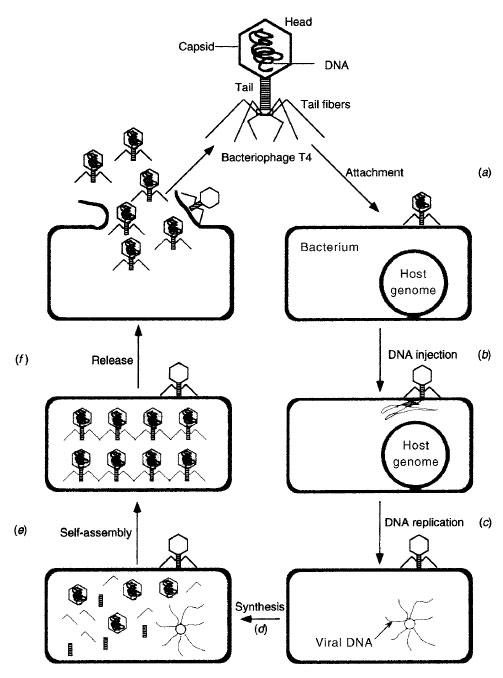Bacteriophages
A bacteriophage is a virus that infects bacteria. Like all viruses, phages are obligate intracellular parasites, devoid of protein synthesizing machinery and energy conversion systems. They contain nucleic acid enclosed in a protein coat, or capsid. Bacteriophages require a living bacterial host in which to carry out their reproductive cycle.The lytic or vegetative life cycle culminates in lysis of the host cell and the release of numerous viral progeny. Bacterial viruses exhibiting only a lytic life cycle are known as virulent bacteriophages because they eventually cause the death and destruction of the host bacterium. For example, the T-even phages such as T2, T4, and T6 are virulent.
The life cycle of T4 is illustrated in Figure 7-1. The lytic cycle consists of five steps. The cycle begins by attachment of the bacteriophage to molecules on the host's cell wall. Next, the virus introduces its genetic material into the cell (penetration). Once the bacteriophage genome enters the cytoplasm, it subverts the host's nucleic acid and protein synthesis apparatus and initiates the synthesis of viral proteins and DNA . As the viral proteins are synthesized, they self-assemble into viral components such as the head (containing the phage DNA ), tail, and tail fibers. The assembly process results in the formation of numerous intact phage particles within the cell. After assembly, viral proteins cause lysis of the host cell, and all the viral progeny are released into the environment.
 |
| Figure 7-1 The lytic cycle of bacteriophage T4. |
A temperate phage can cause a lytic infection, but can also exist within the host bacterium as a prophage, that is when the genetic material of the phage is inserted into the DNA of the host cell. In this state, the lysogenized bacteria can carry out a seemingly normal life cycle. When exposed to UV light or nutrient deprivation, the prophage is excised from the bacterial genome, leading to a lytic cycle.




